
Mysida is an order of small, shrimp-like crustaceans in the malacostracan superorder Peracarida. Their common name opossum shrimps stems from the presence of a brood pouch or "marsupium" in females. The fact that the larvae are reared in this pouch and are not free-swimming characterises the order. The mysid's head bears a pair of stalked eyes and two pairs of antennae. The thorax consists of eight segments each bearing branching limbs, the whole concealed beneath a protective carapace and the abdomen has six segments and usually further small limbs.

Isopoda is an order of crustaceans that includes woodlice and their relatives. Isopods live in the sea, in fresh water, or on land. All have rigid, segmented exoskeletons, two pairs of antennae, seven pairs of jointed limbs on the thorax, and five pairs of branching appendages on the abdomen that are used in respiration. Females brood their young in a pouch under their thorax.
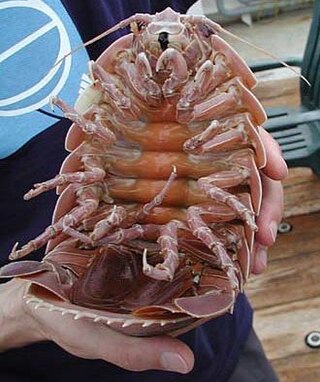
Bathynomus giganteus is a species of aquatic crustacean, of the order Isopoda. It is a member of the giant isopods (Bathynomus), and as such it is related - albeit distantly - to shrimps and crabs. It was the first Bathynomus species ever documented, and was described in 1879 by French zoologist Alphonse Milne Edwards after the isopod was found in fishermen's nets off the coast of the Dry Tortugas in the Gulf of Mexico.

Clam shrimp are a group of bivalved branchiopod crustaceans that resemble the unrelated bivalved molluscs. They are extant and also known from the fossil record, from at least the Devonian period and perhaps before. They were originally classified in the former order Conchostraca, which later proved to be paraphyletic, due to the fact that water fleas are nested within clam shrimps. Clam shrimp are now divided into three orders, Cyclestherida, Laevicaudata, and Spinicaudata, in addition to the fossil family Leaiidae.

Caridina multidentata is a species of shrimp in the family Atyidae. It is native to Japan and Taiwan. Its common names include Yamato shrimp, Japanese shrimp, Amano shrimp, and algae shrimp.

Lysmata amboinensis is an omnivorous shrimp species known by several common names including the Pacific cleaner shrimp. It is considered a cleaner shrimp as eating parasites and dead tissue from fish makes up a large part of its diet. The species is a natural part of the coral reef ecosystem and is widespread across the tropics typically living at depths of 5–40 metres (16–131 ft).
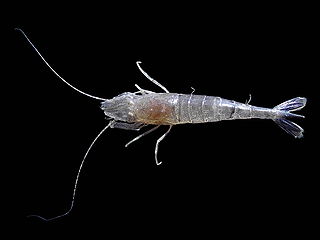
Crangon crangon is a species of caridean shrimp found across the northeastern Atlantic Ocean from the White Sea in the north of Russia to the coast of Morocco, including the Baltic Sea, as well as occurring throughout the Mediterranean and Black Seas. It is commercially important and fished mainly in the southern North Sea. Its common names include brown shrimp, common shrimp, bay shrimp, and sand shrimp, while translation of its French name crevette grise sometimes leads to the English version grey shrimp.
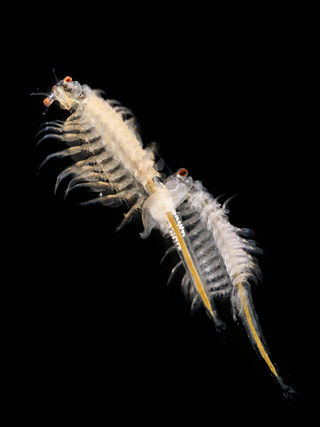
Artemia salina is a species of brine shrimp – aquatic crustaceans that are more closely related to Triops and cladocerans than to true shrimp. It belongs to a lineage that does not appear to have changed much in 100 million years.
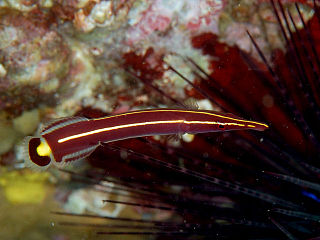
Diademichthys lineatus, commonly known as the long-snout clingfish or urchin clingfish, is a species of marine fish in the family Gobiesocidae.

Eledone moschata, the musky octopus, is a species of octopus belonging to the family Octopodidae.
Chasmodes saburrae, the Florida blenny, is a species of combtooth blenny found in the western central Atlantic Ocean, around the coast of the United States.

Crangon is a genus of shrimp.

Trachysalambria curvirostris is a species of prawn that lives in shallow waters of the Indo-West Pacific. It is one of the most important species targeted by prawn fishery, with annual harvests of more than 300,000 t, mostly landed in China.

Shrimp are crustaceans with elongated bodies and a primarily swimming mode of locomotion – most commonly Caridea and Dendrobranchiata of the decapod order, although some crustaceans outside of this order are referred to as "shrimp".
Heteromysis actiniae, commonly known as the anemone mysid, is a species of opossum shrimp from the family Mysidae found in association with the sea anemone Bartholomea annulata. It is found in the Caribbean Sea and the Gulf of Mexico.
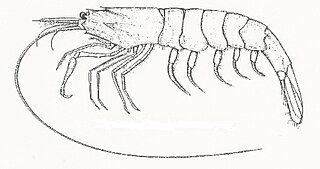
Crangon franciscorum is a species of shrimp in the family Crangonidae which is endemic to the brackish estuaries of California, and found from Puget Sound in the north to San Diego, California in the south. The species is especially abundant in San Francisco Bay, despite population fluctuations due to environmental stresses. Its common names include bay shrimp, sand shrimp, common shrimp, grass shrimp, black shrimp, California shrimp and black tailed shrimp. The species has been commercially fished from 1869 to the present.

Pleurobrachia pileus is a species of comb jelly, commonly known as a sea gooseberry. It is found in open water in the northern Atlantic Ocean, the North Sea, the Baltic Sea and the Black Sea, and was first described by the Danish zoologist Otto Friedrich Müller in 1776.
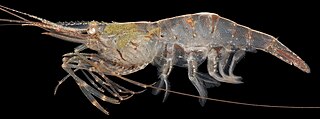
Palaemon macrodactylus is a species of shrimp of the family Palaemonidae.

The horsehair crab, Erimacrus isenbeckii, is a species of crab which is found mainly in the Northwest Pacific, around the Hokkaido coast in the Sea of Okhotsk and the Western Bering Sea and is an important commercial species used in Japanese cuisine. Despite the importance of the species, biological studies are usually specialized and limited. The catch for the species reached a peak in the 1950s at 27,000 tons and has decreased since, reaching 2,000 tons in 2003. Due to the commercial importance of the species, many stock enhancement programs have been utilized to help maintain a successful fishery. The species is commonly found on sandy benthic environments from shallow water to depths of up to 350 meters.
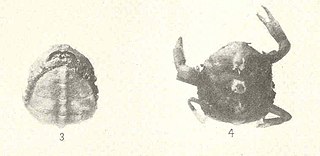
Tunicotheres is a monotypic genus of crabs in the family Pinnotheridae, and Tunicotheres moseri is the only species in the genus. This crab lives commensally in the atrial chamber of a small ascidian. It is found in the tropical western Atlantic Ocean, the Caribbean Sea and the Gulf of Mexico.

















